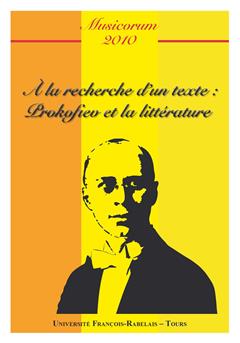



Que ce soit pour de courtes pièces ou pour des opéras, Serge Prokofiev a mis en musique des textes d’une grande variété : utilisant les œuvres de nombreux écrivains (Balmont, Dostoïevski, Brioussov, Tolstoï entre autres), s’inspirant de pièces de théâtre ou de contes (Shakespeare, Perrault, Afanassiev), créant ses propres livrets et scénarios ou collaborant à leur conception avec d’autres artistes (Mira Mendelsohn, Lifar, Kochno), le compositeur a multiplié les sources d’inspirations et s’est essayé à de nombreuses formes d’expression. Ces quelques exemples attestent la variété des auteurs, des sujets et des genres auxquels Prokofiev s’intéressait, et les œuvres qui en ont résulté témoignent d’une grande diversité d’expériences, d’observations et de réflexions menées sur des textes qui, pour la plupart, n’étaient pas initialement destinés à être mis en musique.
Quels choix le compositeur a-t-il faits ? Quelles relations a-t-il tissées entre la musique et le texte littéraire ? Quels rapports a-til entretenu avec les artistes contemporains dont il s’assurait la collaboration ? Ces questions, loin d’être les seules à être abordées, s’inscrivent dans un cadre de réflexion qui, dépassant le seul domaine musicologique, touche à la dramaturgie, la linguistique, l’histoire, l’esthétique, ou encore à la philologie.
________
Whether it be for short pieces or for operas, Sergei Prokofiev set to music a wide range of texts: using works from several writers (among them Balmont, Dostoïevski, Brioussov and Tolstoï), inspired by either plays or tales (Shakespeare, Perrault, Afanassiev), creating his own librettos and scenarios or collaborating with other artists (Mira Mendelsohn, Lifar, Kochno), the composer did all he could to multiply his sources of inspiration and try his hand at various forms of expression. Those few examples testify to the variety of writers, subjects and types which Prokofiev was interested in, and the resulting works are evidence of a great diversity of experiences, observations and reflections carried out on texts that, for most of them, where not intended to be set.
What kind of choices did the composer have to make? What sort of links did he weave between the music and the literary text? What relationship did he keep with the artists he collaborated with? These questions, far from being the only ones to be treated, are in line with an intellectual framework that, beyond the musicological domain, also has to do with analysis, dramaturgy, linguistics, history, esthetics, and even philology.
2010
Prokofiev et la littérature


